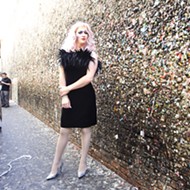Talking about gender
With a new state law in the works, the political conversation opens up for defining more than male or female
By Karen Garcia[{
"name": "Ad - Medium Rectangle CC01 - 300x250",
"id": "AdMediumRectangleCC01300x250",
"class": "inlineCenter",
"insertPoint": "8",
"component": "2963441",
"requiredCountToDisplay": "12"
},{
"name": "Ad - Medium Rectangle LC01 - 300x250",
"id": "AdMediumRectangleCC01300x250",
"class": "inlineCenter",
"insertPoint": "18",
"component": "2963441",
"requiredCountToDisplay": "22"
},{
"name": "Ad - Medium Rectangle LC09 - 300x250",
"id": "AdMediumRectangleLC09300x250",
"class": "inlineCenter",
"insertPoint": "28",
"component": "3252660",
"requiredCountToDisplay": "32"
}]
At the beginning of every quarter, Jay Bettergarcia likes to start off the class discussion by asking students their name, what their major is, and what pronoun they identify with.
Bettergarcia teaches multicultural psychology at Cal Poly. The course lends itself to being a platform to talk about race, racism, sex, sexism, and gender privilege. And the use of gender identifiers and pronouns is now a part of that list.
How a person is identified through pronouns is a conversation that's resurfaced over the last couple of years for some, but Bettergarci
a said it's simply a conversation that more people seem to be willing to have. There are more than 50 gender pronouns and identifiers individuals can use to pinpoint exactly who they are.
"As a professor at Cal Poly, we talk a lot about pronouns and people who don't fit within the binary constructs of male and female," Bettergarcia said.
Although the topic has been around for quite some time, Bettergarcia said the latest talk about identifiers is surrounding the term "nonbinary"—a gender that identifies as neither male nor female. Bettergarcia said it's part of the current conversation because the state Legislature is reviewing it.
Oregon was the first state to legally grant a person, Jamie Shupe,
California might be taking it a step further with state Senate Bill 179. If passed, the bill would recognize nonbinary as a legal gender on official state-issued documents including birth certificates, driver's licenses, and identity cards—without forcing someone to undergo clinical treatment or get a court order.
Nonbinary is a term that can be used by those who aren't comfortable identifying with their birth gender but don't want to transition to another gender.
Bettergarcia identifies as a nonbinary gender and prefers the pronouns that go along with it: "they," "them," and "their."
"It gives people space who feel they are outside of those categories or someone between those categories," they said.
These types of conversations are starting to pop up on Cal Poly's campus at club meetings, organizations, and with professors who are willing to talk about it, Bettergarcia said.
"It's nice to know that this person is using this name and this
Bettergarcia realized that they didn't fit their assigned birth gender during their college years. They started coming out as transgender and began the process of transitioning, but something didn't feel right—Bettergarcia still wasn't comfortable with their identity.
"I realized there was a whole space in between male and female or transgender. I didn't have to identify with one side or another by moving across the binary," they said.
During their time of realization, they said that their family and friends were supportive.
This was a type of open conversation that Malinda Rae wasn't lucky enough to have through her transition from male to female, but she attributes that to the time period in which she grew up. Rae told New Times that she didn't feel comfortable using her full name, so we're using her first and middle name.
Rae grew up in the 1960s and '70s as a male but knew at a young age that she didn't identify as male. When she was in her teens, she told her parents that she identified as a female, but her stepfather didn't take it very well and shut that concept down.
"I assumed I was damaged, and I kind of knew who I was but I was not allowed to be her," Rae said.
For many years, she kept her true identity to herself and continued on as a male for the majority of her life. It wasn't until she reached her 60s that she was able to openly discuss who she was and make the transition from male to female.
To some degree, she still doesn't really talk about her transition, but Rae said that's how she feels the process of transition is for her age group. Whereas now, some people come out as transgender or gay and feel comfortable making their true gender identifiers known—that's not necessarily the case in decades past.
She believes that people her age who made the transition from male to female or female to male did it discreetly.
"Most transgender folk my age wanted to go stealth. Just do your change and go back into society quietly. I just wanted to be a normal woman," Rae said.
She said having an open discussion and having knowledge about various gender identifiers should help normalize the concepts. But she's not sure that everyone is willing to have such an open conversation.
"Now, I'm 66 years old and I feel like I'm 14 just getting ready
to start life, and I don't have to fight all the garbage from the past," she said. Δ
Staff Writer Karen Garcia can be reached at [email protected].
Correction: An earlier version of the story misspelled the first name of the first person to have binary gender status in Oregon. The correct spelling is Jamie Shupe.Latest in News
Readers also liked…
-

Coast Unified teachers upset over new position's salary and qualifications
Oct 20, 2022 -

SLO police identify alleged driver who hit and killed couple
Dec 22, 2022 -

When the levee breaks: Oceano residents, county officials walk a tightrope of regulations to manage Arroyo Grande Creek, which some say led to the levee's failure in January
May 18, 2023










